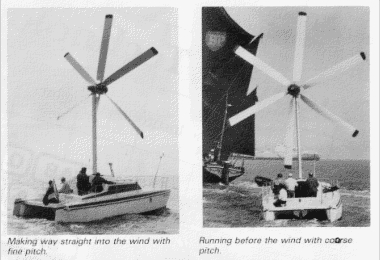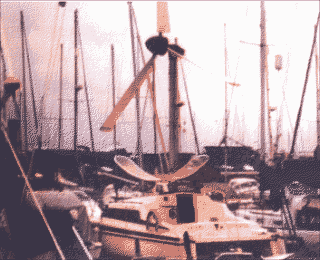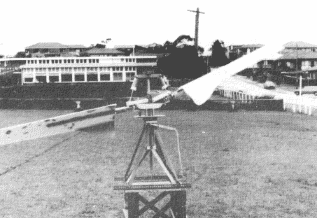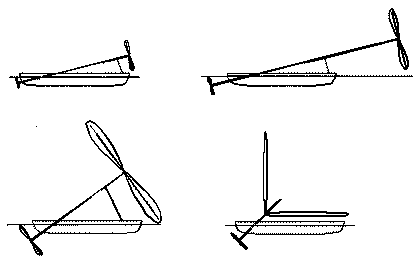Autogiro Boats - History 1980-1995
Table of Contents
| Previous Chapter
| Next Chapter
Denney - 1983/86
Anyway, back to AYRS - in 1983, along came Rob Denney with a serious project. He wanted to build a 28' three bladed wind turbine on a 40' trimaran to take part in the Singlehanded Transatlantic Race in 1984. He thought that the boat would be able to sail directly upwind driving a propeller, be easy to control from inside the cabin, and would put less strain on the boat than ordinary sails.
He built up a sponsorship proposal, and had a team of very well qualified and experienced people behind him, with a trimaran hull designed by the late Rod MacAlpine-Downie, but he did not get any money to build it.
 Anyway, after his attempts at finding sponsorship for this, he found that it was a better idea to write to the suppliers of materials and offer them free publicity in return for free supplies. So, in 1986, he teamed up with Neil Bose from Glasgow University and put a 3-bladed turbine on his Iroquois catamaran.
Anyway, after his attempts at finding sponsorship for this, he found that it was a better idea to write to the suppliers of materials and offer them free publicity in return for free supplies. So, in 1986, he teamed up with Neil Bose from Glasgow University and put a 3-bladed turbine on his Iroquois catamaran.
AYRS 102 (1986) p.23
This boat is now owned by AYRS ex-Chairman Fred Ball, but it no longer has a wind turbine on it. Unfortunately, this is another boat whose photo does not scan very well.
After this, Rob Denney intended to make an attempt at the Sailing Speed record, and did all the calculations and designs, but then had to give up for lack of sponsorship.
Revelation - Wilkinson - 1984/89

Small Craft, 1986, p.47
Then, around 1984, there was Jim Wilkinson, who also teamed up with Neil Bose to put an 24' diameter wind turbine on his 26' Sirrocco catamaran, REVELATION. They did a lot of tests on this boat - measuring the boat speed in all different wind speeds and directions. It seems to do about the same speed in any wind direction. This was an ideal cruising boat, requiring very little work from the crew, but it did not go very fast - going fast was not really the point - it was meant to be a low-effort fun boat.

Photo: F. Sinclair
By the time I went for a ride on this boat in 1989, he had changed it to three blades, and it did about 6 knots. It had also had a safety guard fitted below the blade path to protect the heads of the passengers - although the blades could not actually have hit the passengers, they imagined that they would get hit, and I think the guard rail was more for their psychological reassurance than for their actual safety. It is a lovely boat, all full of push-button controls and labour-saving devices.
Falcon - Bose - 1983/86
 Then there was Neil Bose's own project at Glasgow University between 1983 & 1986. I visited this one and had a ride on it back in 1986, but unfortunately I did not have a camera with me on that occasion. (Also, it was snowing at the time, so maybe photos would not have come out).
Then there was Neil Bose's own project at Glasgow University between 1983 & 1986. I visited this one and had a ride on it back in 1986, but unfortunately I did not have a camera with me on that occasion. (Also, it was snowing at the time, so maybe photos would not have come out).
Glasgow University (1983)
He used a 16' diameter 2-bladed rotor fitted to a helicopter tail rotor hub on a 18' Blackwater sloop named FALCON.
He tried a variety of different blades - twisted, straight, cambered, at different pitch angles, and tried them both as autogiros and driving propellers. The boat sailed at all directions to the wind, including directly upwind. It did not go very fast, but then that was not the idea - it was meant for fuel saving on commercial shipping. It did about 5 kn in a 15 kn wind. He also found gyroscopic force coupling effects - e.g. if a boat travelling upwind yawed to port, this made the bow pitch downwards.
Neil Bose is now the Professor of Ocean Engineering at the Memorial University of Newfoundland, and can be contacted on nbose@engr.mun.ca
Falcon is now in the Scottish Maritime Museum in Irvine.
Tanja - Dumpleton - 1985
 In 1983 Owen Dumpleton had a bright idea for generating electricity on a ship and sending it ashore. This ship was NOT supposed to move about. This arrangement has a number of good points, although those blades and that hull are not amongst them. This design has a very low centre of gravity, and correspondingly low centres of rotation and gyroscopic forces. I will be coming back to them later.
In 1983 Owen Dumpleton had a bright idea for generating electricity on a ship and sending it ashore. This ship was NOT supposed to move about. This arrangement has a number of good points, although those blades and that hull are not amongst them. This design has a very low centre of gravity, and correspondingly low centres of rotation and gyroscopic forces. I will be coming back to them later.
WindTech 1985, p.340
Dusek - 1985

AYRS 101 (1985) p.28
Next we have one of our Australian members, Josef Dusek - in 1984 he patented a device which looks like a helicopter rotor, where the blades flap up half way round, with the energy created by the flapping being used to work a pump. I don't think that he was intending to drive a boat with it.
Gigliobianco - 1986
 And finally amongst the AYRS members of the past publications, there was one of our Italian members, Guiseppe Gigliobianco, who in 1986 put this turbine on a cat, coupled to a vertical-axis propeller. He started off using cloth blades, but later switched to semi-rigid wing blades.
And finally amongst the AYRS members of the past publications, there was one of our Italian members, Guiseppe Gigliobianco, who in 1986 put this turbine on a cat, coupled to a vertical-axis propeller. He started off using cloth blades, but later switched to semi-rigid wing blades.
AYRS 102 (1986) p.21
This chap also took up some of Hugh Barkla's ideas more recently, as you can see from the article in AYRS 112 in 1993.
Elsewhere
There have also been a few people outside AYRS working on wind turbine boats. In the early 1980's, when the price of oil was quite high, there was suddenly quite a lot of research being done on wind-powered ships. There were several one-off conferences and seminars held at this time on commercial sail. Very little of this was actually about wind turbine boats, but they generally got a brief mention. Unfortunately, most of this fizzled out when the price of oil came back down in 1986.
I have only found one publication other than AYRS which published details of wind turbine boat research on anything like a regular basis, and that is the American Symposia on the Aero/Hydronautics of Sailing, also known as The Ancient Interface. There have been a number of papers published over the years on theory and model tests on wind turbine boats, which generally seem to be aimed at travelling directly upwind. Our own member Hugh Barkla has published a lot of theory there, also A.B. Bauer and Brad Blackford are frequent contributors.

Several people have had this idea (top left) - but the obvious drawbacks are: - how do you make it bigger, and can you drive it in any direction apart from directly upwind ?
All the ones that I have seen are seriously underpowered - but what can you do ? To a certain extent, you can increase the length of the axis or increase the tilt, or both but only by quite limited amount. You can scale the whole thing up - but then you still end up with a seriously underpowered boat, which would have to be enormous to get any speed. I believe that the obvious thing to do is to go to a conical turbine. As for going in directions other than upwind - if you run it as an autogiro without a propeller, the whole lot can be made to swivel round.
Table of Contents
| Previous Chapter
| Next Chapter
e-mail to:fnsnclr@gmail.com Anyway, after his attempts at finding sponsorship for this, he found that it was a better idea to write to the suppliers of materials and offer them free publicity in return for free supplies. So, in 1986, he teamed up with Neil Bose from Glasgow University and put a 3-bladed turbine on his Iroquois catamaran.
Anyway, after his attempts at finding sponsorship for this, he found that it was a better idea to write to the suppliers of materials and offer them free publicity in return for free supplies. So, in 1986, he teamed up with Neil Bose from Glasgow University and put a 3-bladed turbine on his Iroquois catamaran. 

 Then there was Neil Bose's own project at Glasgow University between 1983 & 1986. I visited this one and had a ride on it back in 1986, but unfortunately I did not have a camera with me on that occasion. (Also, it was snowing at the time, so maybe photos would not have come out).
Then there was Neil Bose's own project at Glasgow University between 1983 & 1986. I visited this one and had a ride on it back in 1986, but unfortunately I did not have a camera with me on that occasion. (Also, it was snowing at the time, so maybe photos would not have come out). In 1983 Owen Dumpleton had a bright idea for generating electricity on a ship and sending it ashore. This ship was NOT supposed to move about. This arrangement has a number of good points, although those blades and that hull are not amongst them. This design has a very low centre of gravity, and correspondingly low centres of rotation and gyroscopic forces. I will be coming back to them later.
In 1983 Owen Dumpleton had a bright idea for generating electricity on a ship and sending it ashore. This ship was NOT supposed to move about. This arrangement has a number of good points, although those blades and that hull are not amongst them. This design has a very low centre of gravity, and correspondingly low centres of rotation and gyroscopic forces. I will be coming back to them later.
 And finally amongst the AYRS members of the past publications, there was one of our Italian members, Guiseppe Gigliobianco, who in 1986 put this turbine on a cat, coupled to a vertical-axis propeller. He started off using cloth blades, but later switched to semi-rigid wing blades.
And finally amongst the AYRS members of the past publications, there was one of our Italian members, Guiseppe Gigliobianco, who in 1986 put this turbine on a cat, coupled to a vertical-axis propeller. He started off using cloth blades, but later switched to semi-rigid wing blades.